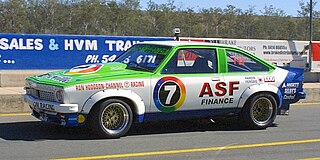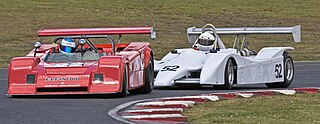The 1981 Australian Touring Car Championship was a CAMS sanctioned motor racing title for drivers of Group C Touring Cars. The championship, which was the 22nd running of the Australian Touring Car Championship, began at Symmons Plains Raceway and ended at Lakeside International Raceway after 8 rounds.

In relation to Australian motorsport, Group C refers to either of two sets of regulations devised by the Confederation of Australian Motor Sport (CAMS) for use in Australian Touring Car Racing from 1965 to 1984. These are not to be confused with the FIA’s Group C sports car regulations, used from 1982 to 1992 for the World Endurance Championship / World Sports-Prototype Championship / World Sportscar Championship and the 24 Hours of Le Mans.
The 1986 Australian Endurance Championship was a CAMS sanctioned motor racing title open to Touring Cars as specified in the National Competition Rules of CAMS. The title, which was the sixth Australian Endurance Championship, was contested concurrently with the 1986 Australian Manufacturers' Championship, which was the sixteenth in a sequence of manufacturers championships awarded by CAMS, and the seventh to be contested under the Australian Manufacturers' Championship name.
The 1983 Australian Endurance Championship of Makes was a CAMS sanctioned national motor racing title open to Group C Touring Cars. The championship was contested over a six round series with all rounds run concurrently with those of the 1983 Australian Endurance Championship.
The 1975 Australian Manufacturers' Championship was a CAMS sanctioned national motor racing title for vehicles manufacturers. The championship was contested over a five round series.
The 1982 Australian Touring Car Championship was a CAMS sanctioned Australian motor racing title open to Group C Touring Cars. It began on 18 February 1982 at Sandown Raceway and ended on 16 May at Oran Park Raceway after eight rounds. The title, which was the 23rd Australian Touring Car Championship, was won by defending champion Dick Johnson, driving a Ford XD Falcon.
The 1978 Australian Championship of Makes was a CAMS sanctioned national motor racing title for car manufacturers. The championship was contested over a five round series.
The 1976 Australian Touring Car Championship was a CAMS sanctioned Australian motor racing title for Group C Touring Cars. It was the 17th running of the Australian Touring Car Championship. The championship began at Symmons Plains Raceway on 29 February and ended at the Phillip Island Grand Prix Circuit on 28 November in the longest season in the history of the series. 1976 saw a substantial change to the ATCC calendar which was expanded to eleven rounds, incorporating the end-of-season long distance Australian Championship of Makes races for the first time. These races included Sandown’s Hang Ten 400 and the Phillip Island 500K, although notably not the Bathurst 1000.
The 1975 Australian Touring Car Championship was a CAMS sanctioned Australian motor racing title open to Group C Touring Cars. The championship began at Symmons Plains and ended at Lakeside after seven rounds. It was the 16th Australian Touring Car Championship.
The 1983 Australian Endurance Championship was a CAMS sanctioned motor racing title for drivers of Group C Touring Cars. The championship was contested over a six round series with all rounds run concurrently with those of the 1983 Australian Endurance Championship of Makes.
The 1987 Australian Manufacturers' Championship was a CAMS sanctioned motor racing title for car manufacturers. The title, which was the seventeenth Australian Manufacturers' Championship, was contested concurrently with the 1987 Australian Touring Car Championship over a nine-round series.
The 1985 Australian Endurance Championship was a CAMS sanctioned motor racing title for drivers of Touring Cars complying with an Australian version of FIA Group A Touring Car regulations. The championship was the fifth Australian Endurance Championship and the fourth to be awarded as a drivers title.
The 1985 Australian Manufacturers' Championship was a CAMS sanctioned motor racing title for car manufacturers. It was the 15th manufacturers title to be awarded by CAMS and the 6th to carry the Australian Manufacturers' Championship name. All championship rounds were open to cars complying with Australian Touring Car regulations, which were based on FIA Group A rules.
The 1979 Australian Sports Car Championship was a CAMS sanctioned motor racing title for drivers of Group D Production Sports Cars. It was the eleventh Australian Sports Car Championship and the fourth to be restricted to cars complying with Group D regulations.
The 1973 Australian Manufacturers' Championship was a CAMS sanctioned motor racing title for automobile manufacturers. It was the third Australian Manufacturers' Championship and the first to be contested with Group C Touring Cars.
The 1981 Australian Endurance Championship was a CAMS sanctioned motor racing title for car manufacturers, contested with Group C Touring Cars. It was the 11th circuit racing manufacturers' championship title to be awarded by CAMS and the first to carry the Australian Endurance Championship name.
The 1971 Australian Manufacturers' Championship was a CAMS sanctioned Australian motor racing title open to Group E Series Production Touring Cars. The championship, which was the inaugural Australian Manufacturers' Championship, was won by General Motors-Holden's.
The 1979 Australian Championship of Makes was a CAMS sanctioned Australian motor racing title open to Group C Touring Cars. It was the ninth manufacturers’ title to be awarded by CAMS and the fourth to carry the Australian Championship of Makes name. The title was awarded to General Motors-Holden.
The 1980 Australian Championship of Makes was a CAMS sanctioned Australian motor racing title open to Touring Cars complying with Group C regulations. It was the tenth manufacturers’ title to be awarded by CAMS and the fifth to carry the Australian Championship of Makes name. The title was awarded to General Motors-Holden.

The 1974 Australian Sports Car Championship was a CAMS sanctioned Australian motor racing title open to Group A Sports Cars and Group D Production Sports Cars. The title, which was the sixth Australian Sports Car Championship, was won by Henry Michell driving an Elfin 360 Repco.




